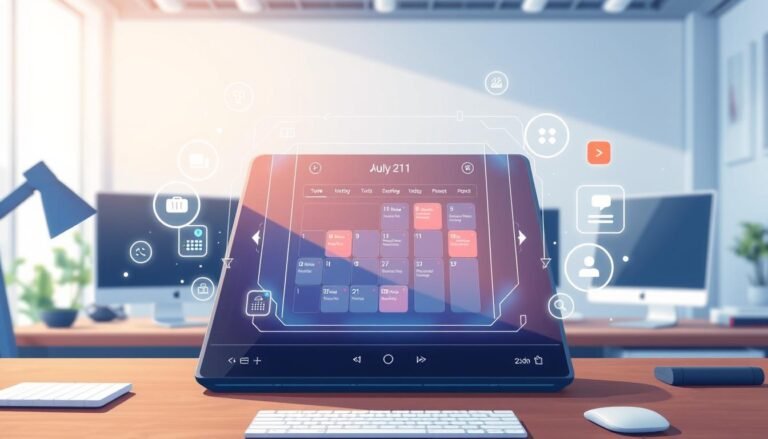Best AI Medical Scribes
Imagine a doctor typing notes instead of talking to patients. This is a common scene today. But, what if we could change this? AI medical scribes are here to revolutionize voice-powered medical documentation.
AI-assisted clinical documentation is more than just tech talk. It’s a real solution to a big problem. Doctors spend 16 minutes on paperwork for every patient. That’s a lot of time taken away from patient care. But, AI medical scribes can save doctors over 70 hours a month on paperwork.
Think about what your doctor could do with 70 extra hours a month. They could spend more time with patients or have a better work-life balance. AI medical scribes are not just tools; they’re partners in care, helping doctors focus on healing.
Key Takeaways
- AI medical scribes can save doctors up to 3 hours daily on documentation
- They can increase productivity by 20% and ensure 99% transcription accuracy
- Some AI scribes can reduce documentation time by up to 50%
- They enhance patient-physician relationships by allowing more focus on patients
- AI scribes are designed for ease of use, often operable via smartphones
The Evolution of Medical Documentation
Medical documentation has changed a lot. It used to be just handwritten notes. Now, it’s all about electronic health records. This big change has made a huge difference in how doctors handle patient info and care for them.
From Handwritten Notes to Electronic Health Records
The move to electronic health records was a big step forward. These digital systems make it easier to access and organize patient data. This helps doctors work better together.
The Burden of Documentation on Healthcare Providers
Even with the benefits, electronic health records have added to the work load of doctors. They now have to deal with a lot of scientific papers. Over their careers, doctors might read up to 113 million papers, or about 2,191 papers every year.
The Rise of AI in Medical Scribing
AI scribe technology is helping doctors with their paperwork. It can write down what happens during patient visits in real time. It works well with electronic health records. A study found that doctors saved about an hour a day by using AI scribes. About 3,442 doctors out of 10,000 started using it in 21 places.
More and more doctors are using AI scribe technology. Almost two-thirds of them see it as a good thing. Doctors in primary care, psychiatry, and emergency medicine are especially excited about it. As AI scribe technology gets better, it will change how doctors document patient care. This will let doctors spend more time on what really matters: taking care of patients.
Understanding AI Medical Scribes
AI medical scribes are changing how we document in healthcare. These virtual helpers use smart tech to aid doctors in writing medical notes. Let’s dive into what they do and their main features.
Definition and Core Functions
AI medical scribes are digital tools that record and write down what happens during doctor visits. They turn conversations into medical notes using speech and language tech. This lets doctors focus more on caring for patients.
Key Features of AI Medical Scribes
- Real-time documentation
- Integration with electronic health records (EHR)
- Automated coding suggestions
- Customizable note templates
- Multi-tasking capability
How AI Medical Scribes Work
AI scribes start by recording audio during visits. They turn speech into text and find important medical details. Then, they fill in the patient’s electronic health record and make a summary.
Doctors can check and change these notes right after the visit. This makes sure the information is right and complete.
| AI Scribe | Note Generation Time | Pricing (per seat) |
|---|---|---|
| Ambience | Seconds | $2800-$3200/year |
| Abridge | Over 1.5 minutes | $2500/year |
| Nabla | ~20 seconds | $119/month |
| Nuance DAX Copilot | Varies | ~$600/month |
AI scribes help doctors by taking over paperwork. This could lead to better care and more time with patients.
Benefits of Implementing AI Medical Scribes
AI-driven healthcare documentation brings big benefits to medical practices. Automated clinical documentation systems change how healthcare providers manage their time and resources.
One key advantage is saving time on documentation. Clinicians with AI medical scribes can chart up to 50% faster. This means they can see 2-3 more patients each day. This boost in efficiency helps more patients and increases revenue for healthcare facilities.
Another big plus is fighting physician burnout. With 63% of doctors feeling burned out, AI scribes help by doing administrative tasks. This lets doctors focus more on patient care, improving care quality and their own well-being.
| Aspect | Impact of AI Medical Scribes |
|---|---|
| Documentation Time | Up to 30% reduction |
| Patient Encounters | 2-3 additional patients daily |
| Charting Time | 50% reduction |
| Administrative Tasks | Significant decrease |
AI medical scribes also make clinical documentation more accurate. They use machine learning to create detailed clinical notes without needing to record them. This leads to better patient care and fewer medical mistakes.
The cost savings of AI medical scribes are also significant. For example, Sunoh.ai can document over 31,000 patient encounters for the cost of one human scribe. This can lead to big savings for healthcare facilities over time.
AI vs. Human Medical Scribes: A Comparative Analysis
The healthcare industry is deciding between AI medical scribing software and human scribes. This analysis looks at their differences in important areas.
Cost Efficiency and Availability
AI medical scribing software is always ready to work and can handle many sessions at once. Human scribes work set hours and need breaks. AI systems have upfront costs but offer steady pricing. Human scribes cost more over time for salaries, benefits, and training.
Accuracy and Consistency
Human scribes are very accurate when they know the medical terms well. They quickly learn new things and understand what doctors prefer. AI scribes work well in all situations with their algorithms. But, they might not handle unique cases as well.
| Feature | AI Medical Scribes | Human Medical Scribes |
|---|---|---|
| Availability | 24/7 | Limited hours |
| Cost | Predictable pricing | Ongoing expenses |
| Accuracy | Consistent performance | High when familiar |
Privacy and Security Considerations
AI medical scribing software has strong security for HIPAA rules. Human scribes need privacy training and sign agreements. AI systems reduce errors but must be set up carefully to protect data.
Using AI with human oversight might be the best choice. It could make healthcare documentation more efficient and accurate while saving money.
Best AI Medical Scribes in the Market
The healthcare world is changing fast with AI medical scribes. These tools help doctors save time and work more efficiently. They make handling paperwork easier.
Nuance DAX
Nuance DAX is a top choice for AI scribes. It uses voice technology to create notes quickly. Doctors can review and sign them in minutes, all while working with popular EHR systems.
Abridge
Abridge helps over 50 medical fields and saves doctors more than 70 hours a month. It’s great for many healthcare settings because of its wide range of features.
Ambience Healthcare
Ambience Healthcare uses voice technology to automate notes. It gives doctors insights and advice to help them make better decisions.
Lyrebird Health
Lyrebird Health is known for its accurate transcriptions and customizable templates. It’s especially useful in Australia, where it works well with the biggest GP EMR.
These AI scribes aim to lessen the paperwork load on doctors. They help doctors spend more time with patients. With features like real-time help and learning, they’re changing how we document in healthcare.
Integrating AI Medical Scribes into Healthcare Practices
Adding AI medical scribes to healthcare changes how doctors work. It makes their jobs easier and faster. Let’s explore how to smoothly integrate this technology.
Compatibility with Existing EHR Systems
AI scribes work best when they match the tools doctors use. Many AI scribes connect with electronic health records (EHR) systems. It’s important to choose an AI scribe that fits with your EHR system for the best results.
Training and Adoption Strategies
Getting everyone to use AI scribes takes effort. Training is key. Doctors and staff need to learn how to use these tools well. Here are some ways to help:
- Hands-on practice sessions
- Step-by-step guides
- Support from tech experts
Overcoming Implementation Challenges
Change can be tough, but there are ways to make it easier. Here are some common challenges and solutions:
| Challenge | Solution |
|---|---|
| Resistance to change | Show how AI scribes save time and reduce stress |
| Tech issues | Have strong IT support ready to help |
| Data security worries | Choose AI scribes with top-notch security features |
With the right approach, AI scribes can make a big difference. They can save doctors up to two hours a day on paperwork. This means more time for patients and less burnout for doctors. As practices adapt, they’ll see smoother workflows and happier staff.
The Impact of AI Medical Scribes on Patient Care
AI medical scribes are changing healthcare by how doctors talk to patients. These digital helpers are big wins for both doctors and patients. They make patient care better.
They save a lot of time on paperwork. Doctors used to spend twice as much time on paperwork as with patients. AI scribes have changed this. Doctors now save about an hour a day on paperwork.
This means doctors can spend more time with patients. A study found that 83.3% of doctors like working with AI scribes more. They feel it makes their job better.
AI scribes also make sure documents are accurate and complete. They catch details that might be missed. This leads to better care and smarter decisions.
- Reduced physician burnout
- Enhanced patient-doctor communication
- Improved documentation accuracy
- More time for patient interaction
The market for AI in healthcare is growing fast. It’s expected to hit $45.2 billion by 2026. We’ll see even more ways AI can help patient care. Healthcare will become more efficient and focused on patients.
Future Trends in AI Medical Scribing Technology
AI is changing how we document in healthcare. New medical scribing tech is coming fast, with big changes ahead.
Advancements in Natural Language Processing
Natural language processing (NLP) is leading in AI scribing. These systems get better at understanding medical terms and context. For instance, The Permanente Medical Group says AI scribes save doctors an hour a day on paperwork.
Enhanced Specialty-Specific Capabilities
AI scribes are learning more about different medical areas. This makes them more accurate and relevant for various specialties. AI tools also help with virtual consultations, making telemedicine better for everyone.
Integration with Other Healthcare AI Tools
The future of AI scribing is combining with other healthcare tech. These systems will work with predictive analytics, languages, and security. AI scribes cut down on errors and make clinical data more accurate.
As AI gets better, we’ll see more advanced scribing tech. It will fit into different healthcare areas, helping patients and doctors work better together.
Conclusion
AI medical scribes are changing how we document healthcare, bringing big benefits. Tools like Freed AI and Abridge make clinical work faster and more accurate. Freed AI, for example, can write notes in just 60 seconds and gets high praise, with an average rating of 4.8/5.
These AI scribes are getting better at understanding medical speech, reaching 95-98% accuracy. They save a lot of time, up to three hours a day, and follow HIPAA rules. Plus, they work well with current EHR systems. Starting at $99/month, they’re a cost-effective way for healthcare providers to improve their work.
The future of healthcare looks bright with AI scribes. By combining AI with human skills, we’ll see even more benefits. This mix will likely make healthcare better, faster, and more accurate. AI scribes are becoming key to improving healthcare and patient care.
Source Links
- Top 4 Best AI Medical Scribes
- The Best AI Medical Scribes [2024 Edition]
- 10 Best AI Medical Scribes (September 2024)
- Medical Scribes: Symptom or Cause of Impeded Evolution of a Transformative Artificial Intelligence in the Electronic Health Record?
- AI scribe saves doctors an hour at the keyboard every day
- AI medical scribes: Understanding who’s out there · Nabla
- How to Select an AI Medical Scribe: A Comprehensive Guide – Zirr AI Medical Scribe
- The top 8 AI Medical Scribes
- 7 Benefits of AI Medical Scribes in Healthcare
- Why Clinicians Can’t Afford to Overlook AI Medical Scribes
- A Step-by-Step Guide to Implementing AI Medical Scribes in Your Clinic
- AI Versus Human Medical Scribes: A Comparison
- ScribeAI vs. Traditional Medical Scribes: A Comparative Analysis
- The Top 5 AI Medical Scribe Companies You Need to Know About
- The Best 5 AI Medical Scribes for any Clinical Profession in Jan 2024 | Lindy
- AI-Powered Medical Scribe Integration within the EHR is Revolutionizing Clinical Documentation
- How to Use an AI Scribe Responsibly in the Clinical Setting
- Artificial intelligence-driven digital scribes in clinical documentation: Pilot study assessing the impact on dermatologist workflow and patient encounters
- How to Maximize Efficiency of an AI-Powered Medical Scribe
- Physicians Guide to exploring AI Medical Scribe in 2024 – Augnito
- Trends in AI Scribe
- How AI is Transforming Medical Scribing
- Best AI Medical Scribes (September 2024)
- Freed AI Review: The Best Medical Scribe for Clinicians?
- AI Medical Scribe Vs. Human Scribe: The Future of Healthcare in 2024







